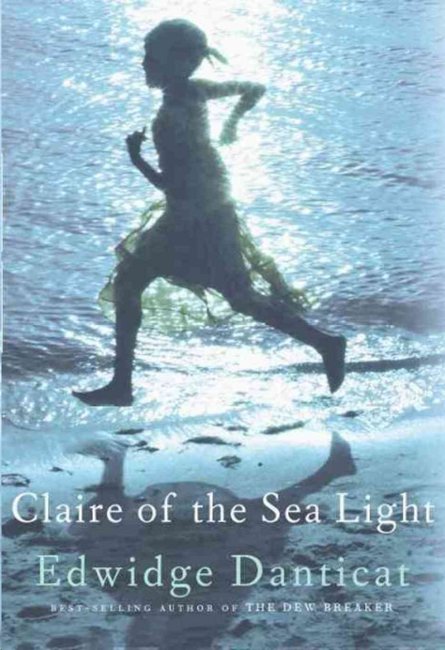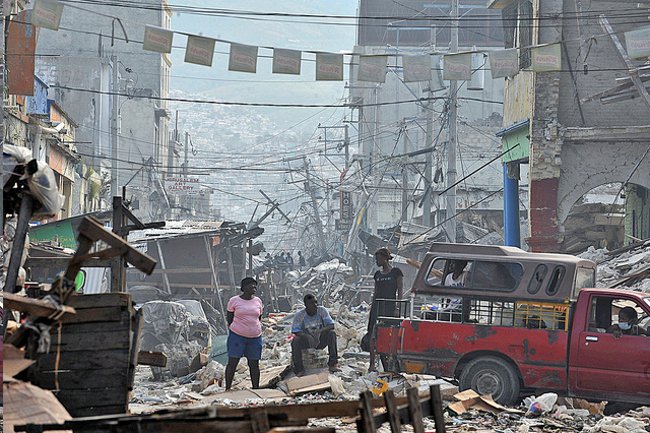Getting Lost in the World of Edwidge Danticat

In August, renowned Haitian-American author Edwidge Danticat released her latest novel, Claire of the Sea Light, after a nearly decade long hiatus. Told through the eyes of several residents of a fictional seaside town called Ville Rose, the story jumps back and forth between the years 1999 and 2009, right before the chaos of the 2010 Haiti earthquake. In it, Danticat offers a multiplicity of voices that interweave with one another to construct a tale about community and the bonds that hold in the midst of political corruption, environmental degradation, poverty, and death. At its core, it is a story about parentage and identity, a story that marks the edge between death and rebirth, turbulence and stasis, and the dissolution and restoration of relationships, auguring Haiti's own courage and resilience in the face of widespread disaster.
Every year on his daughter's birthday, Nozias Faustin takes Claire Limyè Lanmè ("Claire of the Sea Light") to visit her dead mother's grave. An illiterate fisherman hoping to give his only child a better life, Nozias continually offers Claire up for adoption to the wealthy Madame Gaëlle, a fabric store owner who lost her own daughter several years prior. When the novel opens on the day of Claire's seventh birthday, Madame Gaëlle, overcome by loneliness, finally decides to adopt Claire. Directly after announcing her decision, however, the girl goes missing. From this point on, each succeeding chapter chronicles the tale of a different Ville Rose resident--among them a radio talk show host, an aspiring journalist, and a school principal---whose life is somehow connected with Nozias and Claire's. The result is a gleaming tapestry of third-world fables, whose every thread is dyed with equal parts tribulation and triumph.
Despite its luminous title, characters in Claire of the Sea Light are never very far from death, poverty, and destruction. Theirs appears to be a world perpetually on the verge of implosion--whether through its people's own undoing is uncertain. Ville Rose's wealthy comprise an incongruous 5 percent of the population, with the rest being poor, "some dirt-poor." Indeed, the allure of chèche lavi—"going away to make a better life"--is a prime motivator for Nozias' desire to relinquish ownership of Claire. Slum areas like Cité Pendue (known as the region's "first circle of hell") are characterized not only by squalor and agricultural scarcity, but a thriving underworld of gang violence and drug wars.
In the chapter entitled "Ghosts," Bernard, a 19-year-old radio news writer, is framed for the gang-related shooting of Madame Gaëlle's husband, Laurant. Bernard is dragged from his room in the middle of the night, blindfolded, and rigorously questioned, beaten, and taunted by cops. Despite his innocence, the reader is informed that Ville Rose defendants sometimes languish in jail for years before facing a judge. It is only when a gang leader, Tiye, blackmails the town's law enforcement by collecting "drug-related dirt on everyone, from the lowest policeman.....to a few of the area's judges" that Bernard is let go. Unluckily, Gaëlle extracts revenge for her husband's death by having Bernard murdered in his own bedroom.
Bernard, however, is not the only character to meet an early end. Piye and his lieutenant, Tiye, also die by Gaëlle's orders. On the novel's first page, Nozias witnesses Caleb, a local fisherman, being killed by a freak wave. Claire's mother dies giving birth to her. Several years after losing Laurant, Gaëlle's 7-year-old daughter, Rose, is killed when the motto taxi she is riding in is rear-ended. By some darkly humorous act of fate, the town undertaker is elected mayor. Even while living, Claire's mother is surrounded by the dead as she bathes and dresses corpses at the town mortuary.
And people aren't the only ones dying either. A sense of environmental unrest, a kind of foreboding, pervades throughout Claire. When temperatures skyrocket, Ville Rose's frog population is wiped out, their insides inexplicably exploding in the summer heat. Fishermen have begun to reap painfully small catch, indicating a depletion of sea life. Mass flooding is a legitimate concern as peasants continually cut down trees to use for charcoal, causing rivers to overflow, a problem exacerbated by land erosion and the dying topsoil. Sea levels rise, and unusual seismic activity is even hinted at, with the freak wave that kills Caleb in the beginning measuring between 10 and 12 feet high.
So what holds amidst all the chaos? The crux of the novel appears to be in the curious interconnectivity between characters; as is usually the case in towns of this size, everyone seemingly knows everyone. In a world of vast social inequality, shady politics, and an imperiled ecosystem, the bonds of friendship, marriage, and family--even flings--are the sticking glue that holds this community together.
Yet Danticat is concerned with observing what happens when such ties are severed, or at least threatened. Nozias is faced with the pain of giving his only daughter up for adoption. A charismatic schoolmaster must deal with the disappointment of learning a dark secret about his son. Gaëlle loses both husband and daughter only a few years apart from one another. Another woman feels the sting of her lover's waning interest. Suppressed homosexuality nullifies a romance. Other relationships play out with all the ruefulness of a "Missed Connections" ad: a man meets his 10-year-old boy for the first time, only to be told he is never to see him again. Gaëlle nearly has a one-night stand with the man who killed her daughter. Claire never gets to know the woman who gave her both life and namesake, but her presence is felt throughout the entire novel.
Indeed, Claire's relationship with her dead mother is perhaps the most curious of all. Ville Rosians label Claire a ravenan, or a "child who had entered the world just as her mother was leaving it." The death of Claire's mother is not regarded as merely an unfortunate accident, but an ominous exchange of life--because her mother had shown no sign of illness before, it is assumed a struggle of wills took place in which Claire came out the victor. Claire's identity, then, is a stolen one. The fact that people continually compare her to the deceased Claire, both in looks and personality, lends credence to the idea that the living, breathing Claire is merely a continuation of the dead one. Theirs is a relationship that transcends the confines of the material world--one Claire in life, the other in death--, a bond strengthened by the name they both share. In receiving her mother's name, Claire is granted not only identity, but life.

This correlation between names and identity transfer is a theme that pops up several other times in the novel. For example, in the first chapter, the reader only knows Gaëlle as 'the fabric vendor.' It is only when ownership of Claire has finally been transferred to Gaëlle that Nozias "remembers" her name. Nozias' naming of Gaëlle coincides with the formation of her identity as a guardian. She has effectually replaced Nozias as Claire's parent. Or perhaps she has replaced the dead Claire.
The shared names/identity transfer dynamic is also apparent in the would-be relationship between Max Ardin, Jr. (who is, as it were, something of a disappointment to Max Ardin, Sr.) and his 10-year-old son. Upon learning that the boy's mother has named him Pamaxime, Max Junior is somewhat discomfited. Pamaxime, in Haitian Creole, can either mean "Maxime's", or "not Maxime's", depending on the given context. Max Junior, who has until this moment never laid eyes on his son, let alone tried to contact him, is suddenly anxious to know under which context Pamaxime was named. Danticant here uses the mystery behind Pamaxime's name to represent uncertainty between the boy and his estranged father. Any emotional connection between the two is nebulous. Their relationship is as tenuous as their proximity, for though Pamaxime appears to want to know more of Max Junior, his mother is insistent upon him growing up without his father.
Thus Danticat uses name transfer to forge identity in a constantly shifting world that highly values parent-child relationships. Interestingly, Ville Rose labels its gang members (comprised of mostly street urchins whose parents have either abandoned them or been murdered) chimè, for 'chimera' or 'ghost.'

Deft as she is at weaving a tapestry of intricate, psychologically complex relationships, however, Danticat's true brilliance lies in how subtly she peppers other indications of Ville Rosian "sticking glue" throughout the novel. The radio, for example, is a ubiquitous entity in the town, with Ville Rosians tuning in on a daily basis to its wealth of programs, talk shows, soaps, and musical numbers; Danticat all but anthropomorphizes the radio, allowing it to function as a kind of mouthpiece for the Haitian people, its profusion of stories and songs echoing the plurality of voices existing within the country. Ironically, the most salient voice on Ville Rose's airwaves also belongs to one of its loneliest--despite being the unofficial town raconteur, she aches for love and companionship, having very few close friends.
Water and light are two especially strong motifs that consistently weave their way from one chapter to the next. A fishing community that relies heavily on the harvesting of seafood to sustain its economy, Ville Rose looks to the sea not only as a source of sustenance and life, but as a reminder of it. In a moonlit scene brimming with undertones of birth, fertility, and the female mystique, Nozias watches as Claire's mother slips into the ocean, pregnant and topless; a pearlescent glow envelops her as she observes a school of shimmering, silver fish feasting on algae, the light from their scales shining through the water. Moments later she looks to the flickering beams of Ville Rose's lighthouse and declares that her daughter will be named "Claire Limyè Lanmè--Claire of the Sea Light."
It is this interplay between water and light that poignantly evokes the "one-ness" of the living Claire and the dead one, the symbolic unification of mother and daughter through natural phenomena. It is almost as though the sea surrounding Ville Rose, hypnotic in its tidal rhythms, hearkens a return to the primordial soup, or else to the safety and insulation of a mother's womb, as witnessed in the following passage:
"For a while they were twinned, when she was inside her mother's body. But she never dreamed of being inside her mother's body, except in that last moment when she had to come out and that last moment always made her think of water. Sometimes when she was lying on her back in the sea, her toes pointed, her hands facing down, her ears half submerged, while she was listening to both the world above and beneath the water, she yearned for the warm salty water to be her mother's body, the waves her mother's heartbeat, the sunlight the tunnel that guided her out the day her mother died."

Here, it isn't seawater Claire lies awash in, but amniotic fluid, perceptual fragments of her mother's death merging with her own experience into a synthesis of past and present; the rays of sunlight echo the newness of each day, the miracle of perpetuation, of a return to cognition. Even the beams of Ville Rose's lighthouse mimic those of the moon's, long regarded a mystical conduit of maternity and sexual awakening.
Finally, as is fitting for a community as deeply alive and diverse as Ville Rose, water in Claire of the Sea Light takes on an emotive quality that often reflects the violence of the life cycle. Local fishermen keep an amulet in their boats to invoke the protection of Lasirèn, the goddess of the ocean who is believed to appear before sailors at the moment of death. Caleb is killed by a freak wave, rivers swell over, and rain is often used to portray internal angst, as when a rape occurs during a violent thunderstorm. At one point, a pregnant Gaëlle, having been told by doctors that the child she is carrying will be a stillborn, swallows a dead koki (a type of small, Caribbean frog) in an act of psuedo-ritualistic animism so that the two bodies inside of her may "fight it out." Curiously enough, frogs, associated with water, are often taken as symbols of cleansing, renewal, and rebirth. What, then, might a dying frog population portend? What happens next is astonishing: shortly after swallowing the koki, Gaëlle goes into labor. In a disturbingly ravenan-esque exchange of life, the child is miraculously born alive and healthy, and that same evening Laurant is shot dead. Ironically, the reader knows this same child will die a mere seven years later in a vehicular accident.
Lamentable though such a turn of events may be, however, is not the oscillating roar and quietus of life in Ville Rose--with its freak waves and herpicide, blood money and heartbreak, ravenan and chèche lavi--a scrupulous mirroring of all the political and social bedlam that is modern Haiti? Danticat is, of course, no stranger to examining ongoing issues within her home country through culturally immersive fiction, and Claire is no different. In an interview with Jeffrey Brown on PBS last month, the author elaborated on this mirroring by describing Haiti as living within a kind of flux marked by increasing struggle:
"You try to present a world in a way you would like it to be. You try to solve problems in a way you wish they would be solved. There's also an acknowledgement of the present, because Haiti lives in a very ever urgent present, even with this extraordinary history, extraordinary art, extraordinary people, but it also lives in a very difficult present."
If Claire is an acknowledgement of the present, though, how does its stories address Haiti's unquestionably altered geographical, political, and emotional landscape that resulted from the 2010 disaster?
According to Danticat, it doesn't:
"The earthquake is part of now the present of Haiti, and (it) will always have a life before the earthquake, a life after the earthquake. I personally don't feel capable or ready yet to write stories that are set after the earthquake, so I wanted to set this story actually on the cusp--you know, this town, it's right before the earthquake and how people were living their lives, and maybe it's my attempt to hang on a little bit longer to something that was."
So what can one take from all the demise and despair so prevalent throughout Danticat's most recent work, aside from a heightened awareness of Haiti's economic and environmental struggles?
Just as tenants of Ville Rose are forever at the mercy of juggernauts like poverty, classism, greed, and environmental calamity, so, too, must Haiti--and the rest of the world--reconcile itself with the fact that we find ourselves in the grip of forces so insurmountably powerful and deadly as to constantly threaten our own annihilation, whether they be the contagion of racism and religious intolerance, nuclear warfare, or a meteorite-induced apocalypse.
To this sobering truth, Danticat offers the oft-repeated phrase, "Fòk nou voye je youn sou lòt"--"We must all look after each other." Ville Rosian "sticking glue" is really a premium placed on a pancultural constant, the bedrock of all societies--that biologically-hardwired instinct to optimize likelihood of survival, as well as relieve existential anxiety, through consolidation and interaction with other human beings. The precariousness of our existence in no way lessens our will to survive, or, for that matter, our desire for permanence; the collective paroxysm of grief left in the wake of the 2010 earthquake no lessened the inherently human impulse to rebuild towards homeostasis, or the impulse to thrive and procreate. For this reason, the deceased Claire remains a champion over nihility. Just as genetic extension secures permanence, a tightly knit community provides resources and breeds resilience, both crucial factors to sustaining life in a perilous climate.
Author Bio:
Kaitlyn Fajilan is a contributing writer at Highbrow Magazine.
Photos: David Shankbone (Wikipedia Commons); BitHead (Flickr); RIBI Image Library (Flickr).





























































































































































































































































































































